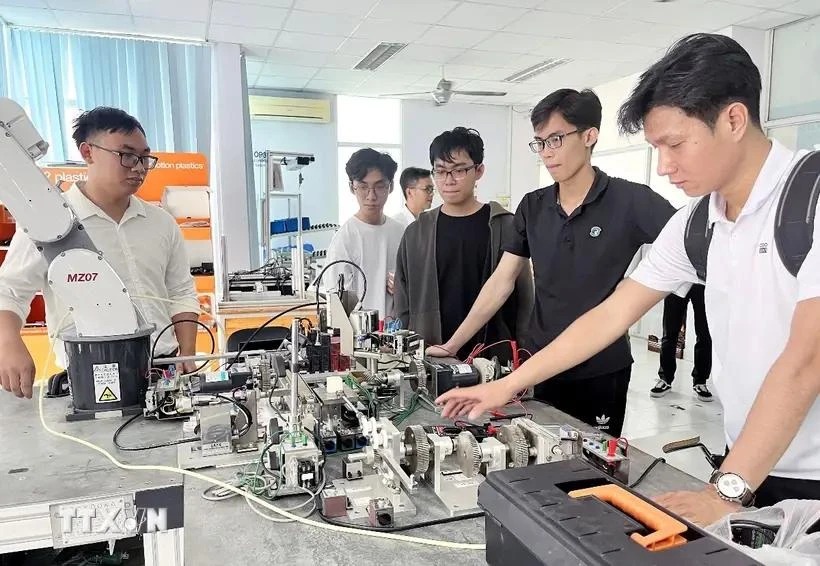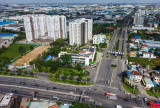Strategy issued to develop Vietnam’s semiconductor industry
Prime Minister Pham Minh Chinh has signed a decision issuing the strategy for developing Vietnam’s semiconductor industry by 2030, with a vision to 2050.

Students in a practice session at the Saigon Hi-tech Park Training Centre of Ho Chi Minh City (Illustrative photo: VNA)
Prime Minister Pham Minh Chinh has signed a decision issuing the strategy for developing Vietnam’s semiconductor industry by 2030, with a vision to 2050.
The strategy outlines a roadmap for developing the industry according to the formula of C = SET + 1 (C stands for Chip, S for Specialised, E for Electronics, T for Talent, and + 1 for Vietnam, which will strive to become a new and safe destination of the global semiconductor supply chain).
The country plans to develop the industry in three phases.
In the first from 2024 - 2030, it will make use of geopolitical and workforce advantages, selectively attract foreign direct investment (FDI), establish itself as one of the global semiconductor manpower centres, and grow fundamental capacity in all steps, from research, design, and manufacturing to packaging and testing.
In the second from 2030 - 2040, Vietnam will work to become a global semiconductor and electronics centre while developing the semiconductor and electronics industries that combine both self-reliance and FDI.
For the third phase from 2040 - 2050, it looks to become one of the world’s leaders in the semiconductor and electronics industries, and master research and development (R&D) in these fields.
Identifying concrete targets for each period, in Phase 1, the country will selectively attract FDI; form at least 100 design companies, one small-scaled manufacturing factory, and 10 packaging and testing plants; and develop some specialised semiconductor products for several sectors.
The semiconductor industry is hoped to secure annual revenue of more than 25 billion USD and an added value growth rate of 10 - 15%. Meanwhile, the electronics industry targets over 225 billion USD in annual revenue and also 10 - 15% in added value growth.
The semiconductor workforce will include more than 50,000 engineers and graduates, with an appropriate structure and number, to meet development demand during 2024 - 2030.
In Phase 2, Vietnam will develop a semiconductor industry combining both self-reliance and FDI, with at least 200 design companies, two manufacturing factories, and 15 packaging and testing plants, and gradually ensure self-sufficiency of design and production technologies for specialised semiconductor products.
It targets respective annual revenues of over 50 billion USD and 485 billion USD for the semiconductor and electronics industries, which are expected to record an added value growth rate of 15 - 20%.
Meanwhile, more than 100,000 semiconductor engineers and graduates will be available during 2030 - 2040.
In Phase 3, there will be at least 300 design companies, three manufacturing factories, and 20 packaging and testing plants. The country is also set to master semiconductor R&D.
The semiconductor and electronics industries are expected to post respective annual revenues of more than 100 billion USD and 1.045 trillion USD, as well as a growth rate of 20 - 25% in added value.
At that time, the semiconductor workforce will feature an appropriate structure and number meeting development demand.
Besides, Vietnam will complete a self-reliant semiconductor industry ecosystem taking the lead in some steps and segments of the production chain during 2040 - 2050, according to the strategy.
To that end, five major tasks with detailed implementation measures are also specified in this strategy./.
VNA
 Multiplying exemplary models of the "Excellent and Creative Labor" Emulation
Multiplying exemplary models of the "Excellent and Creative Labor" Emulation
 Logistics companies take advantage of opportunities to innovate and grow
Logistics companies take advantage of opportunities to innovate and grow
 Counterfeit, smuggled goods on e-commerce platforms: Current situation and solutions
Counterfeit, smuggled goods on e-commerce platforms: Current situation and solutions
 Coordination programs are guaranteed to be practical and effective
Coordination programs are guaranteed to be practical and effective
 ENTERPRISES LISTED IN THE GREEN BOOK: Role models on sustainable environmental protection
ENTERPRISES LISTED IN THE GREEN BOOK: Role models on sustainable environmental protection
 Binh Duong-Yamaguchi (Japan): Ten-year connection
Binh Duong-Yamaguchi (Japan): Ten-year connection
 Binh Duong-Ymaguchi (Japan): Ten-year connection
Binh Duong-Ymaguchi (Japan): Ten-year connection
 Binh Duong - Yamaguchi (Japan): Ten-year connection
Binh Duong - Yamaguchi (Japan): Ten-year connection
 The driving force incurred by major constructions
The driving force incurred by major constructions
 Vietnam needs 14 billion USD to develop EV charging stations
Vietnam needs 14 billion USD to develop EV charging stations




